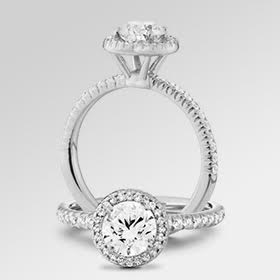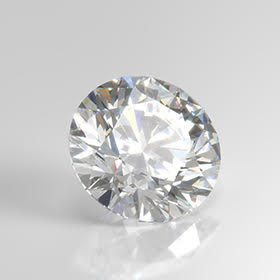Shopping for diamond gifts can be a really hard process — especially if you’re shopping for ethical diamonds. Perhaps you’ve turned to lab-created diamonds because you’ve heard that they are more affordable, more sustainable, and more ethical. But then again, there are a lot of other not-so-great (false!) things you’ve heard about lab diamonds, like that they are synthetic or don’t have resale value. This is largely due to the mined diamonds industry, which fears it will be totally disrupted once people learn the tremendous advantages of lab diamonds. We’re here to help you sort the fiction from the facts and to bust these lab diamond myths once and for all. Here are the top five myths about lab diamonds:
Myth #1: Lab-grown diamonds aren’t real diamonds.
The power of language! This is a huge marketing myth spread by those invested in mined diamonds that seeks to discredit the reputation of lab diamonds. The idea behind spreading this myth is that people will feel like they are getting an inferior product if they believe that their ethical diamonds from a lab aren’t actually “real.” But the truth of the matter is that lab diamonds are as real as mined diamonds; in fact, they are basically identical. The only difference in their formation is the setting in which they respectively were created; mined diamonds form in the Earth, whereas lab diamonds are created in the lab. That’s it! They both are made from carbon and share the same physical, chemical, and optical properties. If that’s not enough to be considered a “real” diamond, then, well, we’re not sure what is! You can read more about why lab diamonds are indeed real diamonds here.
Myth #2: Lab-grown diamonds are synthetic diamonds.
Another marketing scheme, lab diamonds have incorrectly been coined as “synthetic” diamonds since their inception. But even the FTC is calling foul on this one, as it amended its Jewelry Guides in July 2018 to prohibit the words “natural” and “synthetic” from being used in diamond marketing. Recognizing the science that allows for lab diamonds to be made exactly like Earth-formed diamonds, the FTC noted, “ A diamond is a diamond no matter whether it is grown in a lab or comes out of the ground.”
The correct terminology for stones that are meant to look like diamonds (but aren’t actually diamonds) is “diamond simulants” and are found in imitation diamond rings and chosen by those who like the budget-friendly price tag (and are perhaps searching for ethical diamonds). The most common examples of simulant diamonds are cubic zirconia and moissanite; they do not share the same chemical structure as diamonds and are created from zirconium dioxide and silicon carbide, respectively. But again, since lab diamonds are made from crystallized carbon just like mined diamonds, they are NOT diamond simulants.
Myth #3: Lab-grown diamonds aren’t as durable as mined diamonds.
One of the reasons that diamond gifts became so popular is because of the infamous phrase, “Diamonds are forever.” This is, of course, an indication of the strength and durability of diamonds, which are one of the hardest substances on Earth. Some consumers have been led to believe that lab diamonds do not share this same durable quality with Earth-formed diamonds, but that’s totally false. It all boils down, once again, to the shared composition properties. Because both types of diamonds are made from carbon and have the same physical characteristics, they share the same durability. We wrote a blog specifically about the durability of lab diamonds if you’d like to learn more.
While we’re on the topic of physical characteristics, we’ll also point out that if you’ve heard that lab diamonds might fade or become discolored over time, that is also completely untrue. With the exact same carbon crystallization as an Earth diamond, you can rest assured that your lab diamond won’t crack, fade, or change colors just because it was made in a controlled environment.
Myth #4: Lab-grown diamonds don’t have resale value.
Back to that “Diamonds are forever” line, many people believe that their diamond rings are great investments due to their resale value. Unfortunately, this is a myth itself. While it’s true that you can somewhat easily resale diamonds, they depreciate in value and you’ll never get more than what you paid for it when you sell it (unless it’s an extremely rare colored diamond that gets auctioned, like the Pink Legacy diamond!). However, do know that there is a market for lab diamonds just like there is for mined diamonds, and you can certainly resale a lab diamond.
Myth #5: Lab-grown diamonds aren’t eco-friendly.
One of the reasons that so many people turn to lab diamonds for their diamond gifts is because they know that they are ethical diamonds — for people and for the planet. However, there is some fogginess around the sustainability of lab diamonds, only because of how they first were created with a High Pressure High Temperature (HPHT) method. This method mimics the natural process of diamond formation within the Earth’s crust, but indeed, it does require a lot of electricity (still, not as much as it takes to mine for diamonds!). The newer method of creating diamonds in the lab is known as Chemical Vapor Distillation (CVD), and it requires much less energy than the HPHT. This is the method we use to create our diamonds at New World Diamonds, and we’re proud of our commitment to better-for-Earth, conflict-free, ethical diamonds.
Have you heard other things about lab diamonds that you’d like to talk with us about? We’d be happy to have a conversation with you to dispel any myths you’ve heard! We want you to feel confident when you’re buying diamond rings and other diamond gifts from us. There are several ways to get in touch with us: you can call us at 877-653-2250, email us at hello@newworlddiamonds.com, or fill out this contact page and we’ll get back to you asap. If you want to learn more about lab diamonds, you can read more on our blog. Here’s to informed consumerism — and myth busting!









